AUDI A3 SEDAN 2018 Owners Manual
Manufacturer: AUDI, Model Year: 2018, Model line: A3 SEDAN, Model: AUDI A3 SEDAN 2018Pages: 404, PDF Size: 62.3 MB
Page 251 of 404
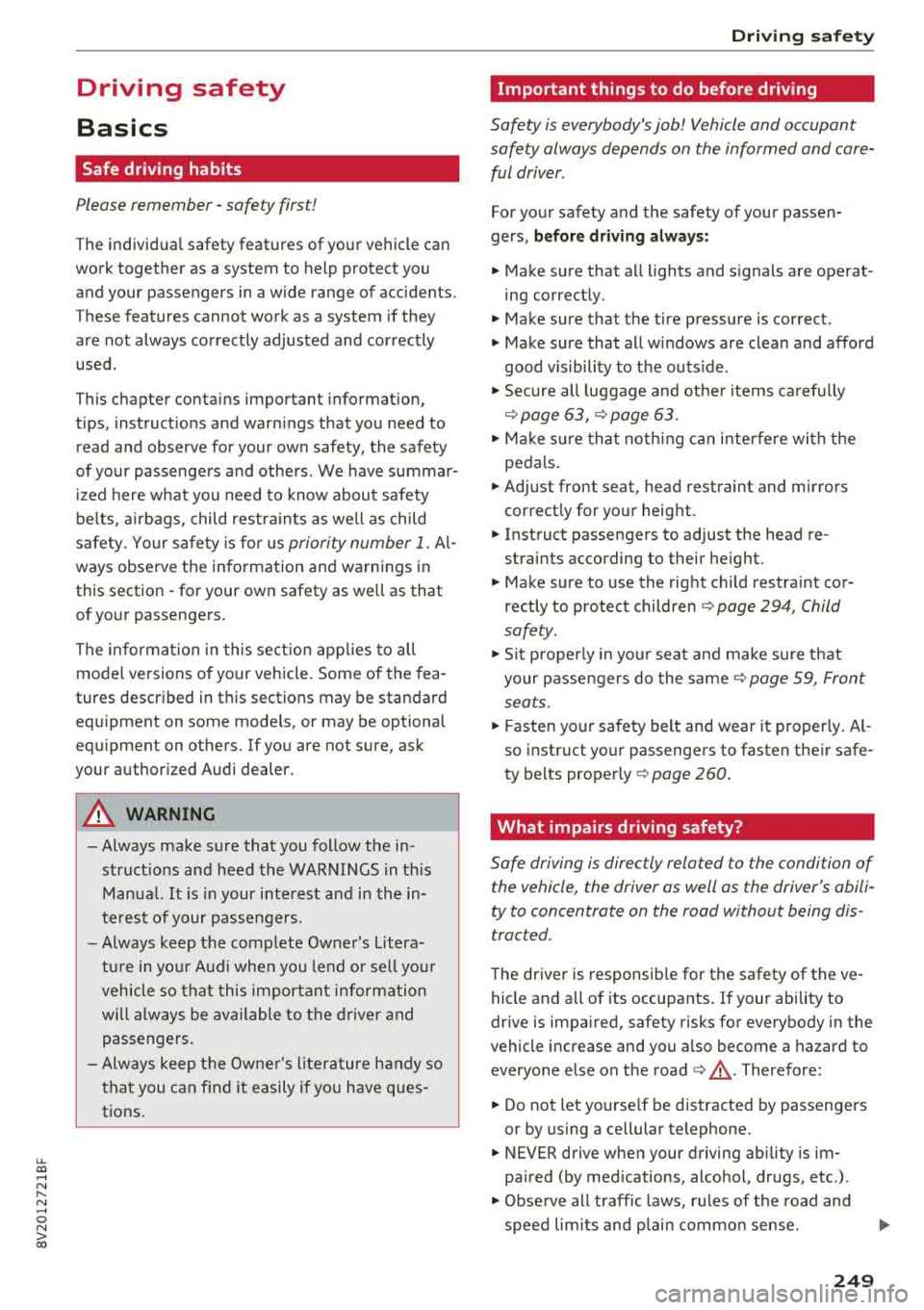
u. 00 .-< N l' N .-< 0 N > 00
Driving safety
Basics
Safe driving habits
Please remember -safety first!
The individual safety features of your vehicle can
work together as a system to help protect you
and your passengers in a wide range of accidents.
These features cannot work as a system if they
are not always correctly adjusted and correctly
used .
This chapter contains important informat ion,
tips, instructions and warnings that you need to
read and observe for your own safety, the safety
of your passengers and others . We have summar
iz ed here what you need to know about safety
belts, airbags, child restraints as well as child
safety. Your safety is for us
priority number 1. Al
ways observe the information and warnings in
this section -for your own safety as well as that
of your passengers.
The informa tion in t his section applies to all
model versions of your vehicle. Some of the fea
tures described in this sections may be standard
eq uip ment on some models, or may be optional
equ ipment on others. If you are not sure, ask
your author ized Audi dealer.
A WARNING
-Always make sure that you follow the in
struct ions and heed the WARNINGS in this
Manual. It is in your interest and in the in
terest of your passengers .
-
-Always keep the complete Owner's Litera
ture in your Audi when you lend or sell yo ur
vehicle so that this important information
w ill always be available to the driver and
passengers.
-Always keep the Owner's literature handy so
that you can find it easily if you have ques
tions .
Driving safety
Important things to do before driving
Safety is everybody 's job ! Vehicle and occupant
safety always depends on the informed and care
ful driver .
For your safety and the safety of your passen
gers,
before driving always:
.. Make sure that a ll lights and signals are operat
ing correctly.
.. Make sure tha t the tire pressure is correct .
.. Make sure that all w indows are clean and afford
good vis ibility to the outs ide.
.. Secure all luggage and othe r items ca refully
c::> page 63, c::> page 63 .
.. Make sure that nothing can interfere with the
peda ls .
.. Adjust front seat, head restraint and mirrors
correct ly for your height.
.. Instruct passengers to adjust the head re
straints according to their height.
.. Make sure to use the right child restraint cor
rectly to protect children
c::> page 294, Child
safety .
.. Sit properly in your seat and make sure t hat
your passengers do the same
c::> page 59, Front
seats .
.. Fasten your safety belt and wear it properly. Al
so instruct your passengers to fasten their safe
ty belts properly
c::> page 260.
What impairs driving safety?
Safe driving is directly related to the condition of
the vehicle , the driver as well as the driver 's abili
ty to concentrate on the road without being dis
tracted.
The driver is responsible for the safety of the ve
hicle and a ll of its occupants. If your ability to
drive is impa ired, safety risks for everybody in the
vehicle increase and you a lso become a hazard to
everyone else on the road
c::> &_ . Therefore:
.. Do not let yourse lf be distracted by passengers
or by using a cellular telephone .
.. NEVER drive when your driving abi lity is im
pa ired (by med ications, alcohol, drugs, etc .) .
.. Observe all traffic laws, rules of the road and
speed lim its and plain common sense .
.,.
249
Page 252 of 404
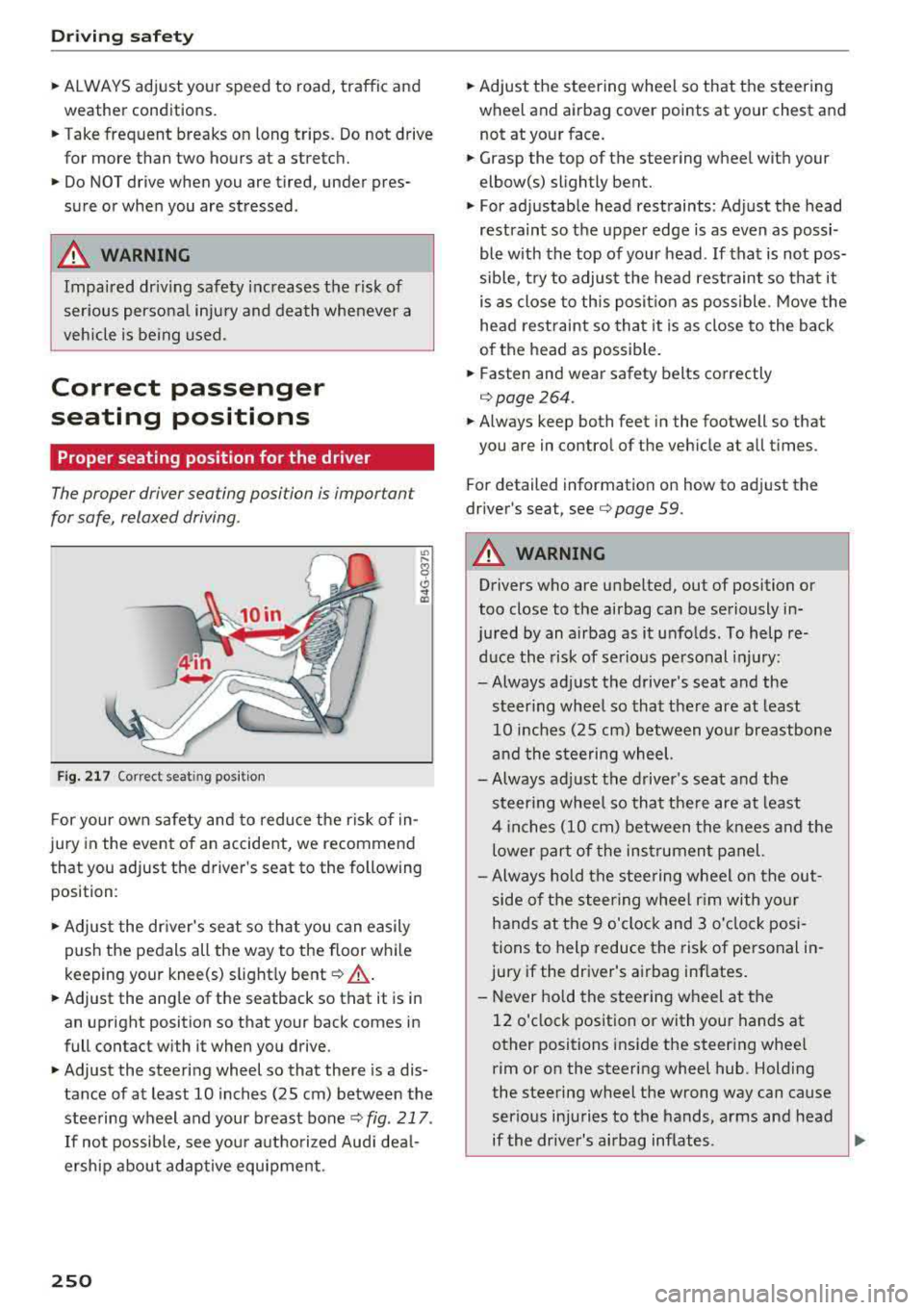
Driving sa fety
,.. ALWAYS adjust your speed to road, traffic and
weather conditions.
,.. Take frequent breaks on long trips. Do not drive
for more than two hours at a stretch.
,.. Do NOT drive when you are tired, under pres
sure or whe n you are stressed .
A WARNING
Impaired driv ing safety inc reases the risk of
ser ious persona l inju ry and death whenever a
vehicle is being used.
Correct passenger
seating positions
Proper seating position for the driver
The proper driver sea ting po sition is impor tan t
for safe, relaxed driving .
Fig. 217 Correc t seat ing posit ion
F or your own safety and to reduce the risk of in
jury in the event of an accident, we recommend
that you adjust the driver 's seat to the following
position :
,.. Adjust the dr iver's seat so tha t you can easily
push the pedals all the way to the floor whi le
keeping your knee(s) s light ly
bent ¢ ,A.
,.. Adjust the angle of the seatback so that it is in
an upright position so that your back comes in
full contact with it when you drive.
,.. Adjust the steering wheel so that there is a dis
tance of at least 10 inches (25 cm ) between the
stee ring wheel and your breast bone
<=;> fig . 217 .
If not possib le, see you r autho rized Aud i dea l
ersh ip about adaptive equipment .
250
,.. Adjust the steering wheel so that the steering
wh eel and airbag cover points at your chest and
not at your face.
,.. Grasp the top of the steering wheel with your
elbow(s) slightly bent.
,.. F or ad justab le head rest raints: Adjust the head
restraint so t he upper edge is as even as possi
ble with the top of your head . If that is not pos
sible, t ry to adjust the head restraint so tha t it
is a s close to this pos it ion as poss ible . M ove the
he ad restraint so tha t it is as close to the back
o f the head as possible.
,.. Fasten and wear safety belts correctly
q page264 .
,.. Always keep both feet in the footwell so that
you are in contro l of the veh icle at all times .
Fo r detail ed information on how to adjust the
dr iver's seat,
see ¢ page 59.
A WARNING
Drivers who are unbelted , out of position or
too close to the airbag can be seriously in-
jured by an airbag as it unfo lds . To help re-
duce the risk of serio us pe rsonal i njury:
-Always adjust the driver's seat and the steer ing whee l so that there are at least
10 inches (25 cm) between you r breastbone
and the steering wheel.
- Always ad just the driver's seat and the
steer ing whee l so that the re are at least
4 inch es (10 cm) between the knees a nd the
lower part of the ins trumen t panel.
-Always hold t he s teering wheel on the out
side of t he steering wheel r im with yo ur
hands at the 9 o'clock and 3 o'clock posi
tions to help reduce the risk of personal in
jury if the dr iver 's airbag inflates.
-Never hold the stee ring wheel at the
12 o'clock position or with you r hands at
other positions inside the steer ing whee l
rim o r on the steering wheel hub. Holding
the steering wheel the wrong way can cause
serious injuries to the hands, arms and head
-
if the driver's airbag inflates . .,_
Page 253 of 404
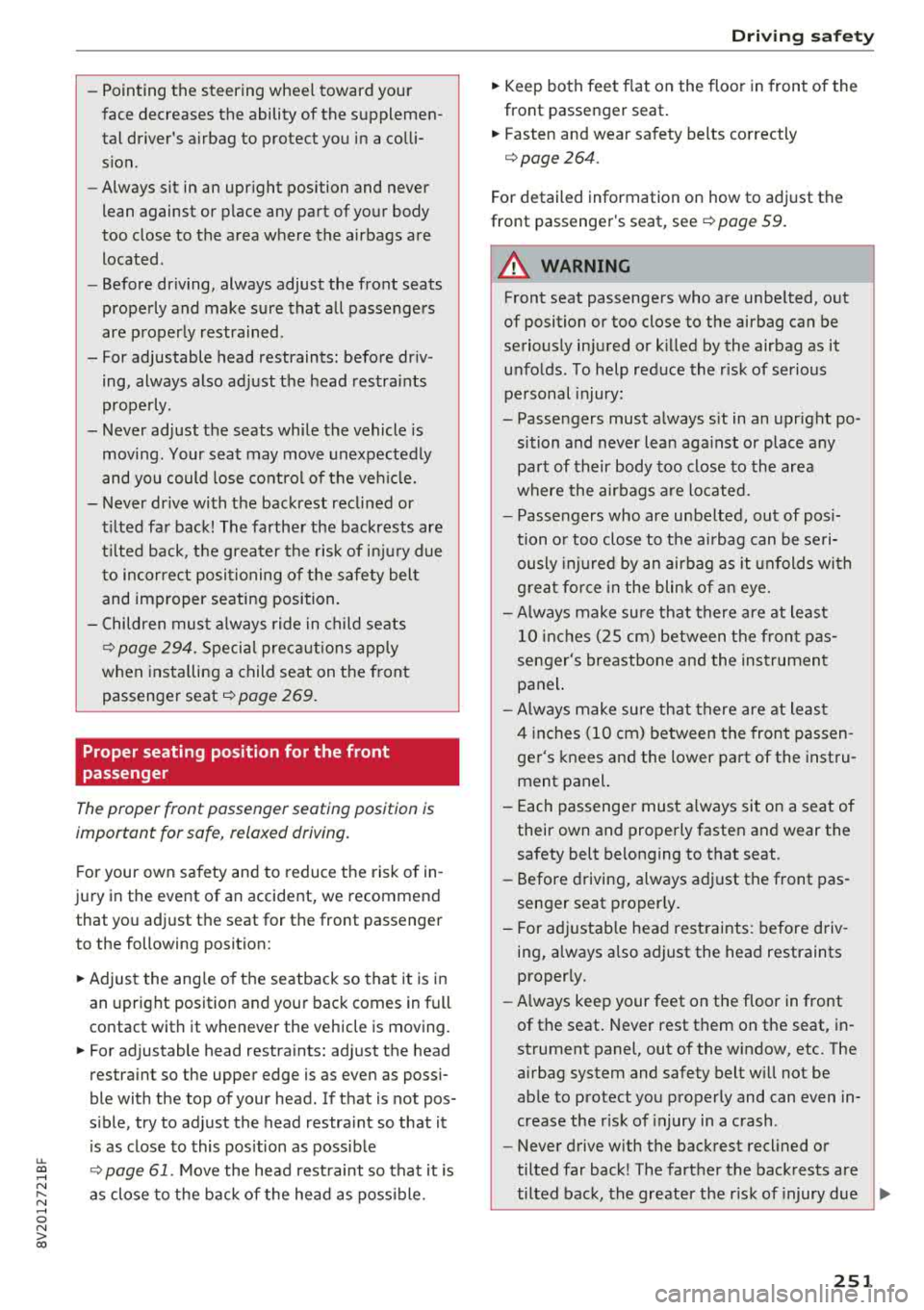
u. 00 .-< N l' N .-< 0 N > 00
-Pointing the steering wheel toward your
face decreases the ability of the supplemen
tal driver's airbag to protect you in a colli sion.
- Always sit in an upright position and never
lean against or place any part of your body
too close to the area where the airbags are
located.
- Before driving, always adjust the front seats
properly and make sure that all passengers
are properly restrained.
- For adjustable head restraints : before driv
ing, always also adjust the head restraints
properly.
- Never adjust the seats while the vehicle is moving . Your seat may move unexpectedly
and you could lose control of the vehicle.
- Never drive with the backrest reclined or
tilted far back! The farther the backrests are
tilted back, the greater the risk of injury due
to incorrect positioning of the safety belt
and improper seating position.
- Children must always ride in child seats
~ page 294. Special precautions apply
when installing a child seat on the front
passenger seat
i::> page 269 .
Proper seating position for the front
passenger
The proper front passenger seating position is
important for safe, relaxed driving.
For your own safety and to reduce the risk of in
jury in the event of an accident, we recommend that you adjust the seat for the front passenger
to the following position:
.. Adjust the angle of the seatback so that it is in
an upright position and your back comes in full
contact with it whenever the vehicle is moving.
.. For adjustable head restraints: adjust the head
restraint so the upper edge is as even as possi
ble with the top of your head. If that is not pos
sible, try to adjust the head restraint so that it
is as close to this position as possible
~ page 61. Move the head restraint so that it is
as close to the back of the head as possible.
Driving safety
.. Keep both feet flat on the floor in front of the
front passenger seat.
.. Fasten and wear safety belts correctly
<=:>page 264.
For detailed information on how to adjust the
front passenger's seat, see
<=:>page 59.
A WARNING
= -
Front seat passengers who are unbelted, out
of position or too close to the airbag can be
seriously injured or killed by the airbag as it
unfolds . To help reduce the risk of serious
personal injury:
- Passengers must always sit in an upright po
sition and never lean against or place any part of their body too close to the area
where the airbags are located.
- Passengers who are unbelted, out of posi
tion or too close to the airbag can be seri
ously injured by an airbag as it unfolds with
g reat force in the blink of an eye.
- Always make sure that there are at least
10 inches (25 cm) between the front pas
senger's breastbone and the instrument panel.
- Always make sure that there are at least
4 inches (10 cm) between the front passen
ger's knees and the lower part of the instru
ment panel.
- Each passenger must always sit on a seat of
their own and properly fasten and wear the
safety belt belonging to that seat.
- Before driving, always adjust the front pas
senger seat properly.
- For adjustable head restraints: before driv
ing, always also adjust the head restraints
properly .
- Always keep your feet on the floor in front
of the seat. Never rest them on the seat, in
strument panel, out of the window, etc. The
airbag system and safety belt will not be
able to protect you properly and can even in
crease the risk of injury in a crash .
- Never drive with the backrest reclined or
tilted far back! The farther the backrests are
tilted back, the greater the risk of injury due
~
251
Page 254 of 404
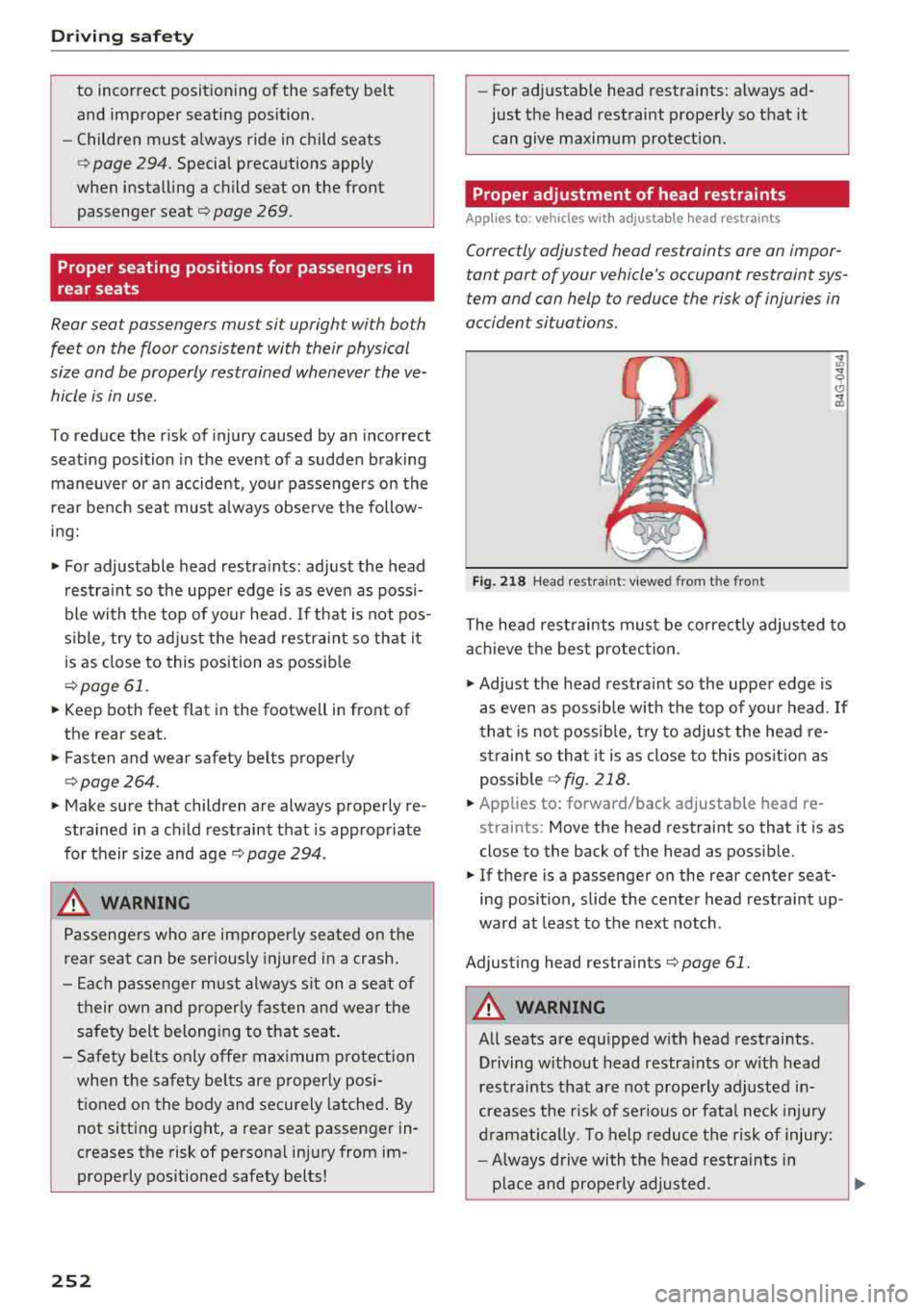
Driving safety
to incorrect positioning of the safety belt
and improper seating position.
- Children must always ride in child seats
c:> page 294. Special precautions apply
when installing a child seat on the front passenger seat
c:> page 269.
Proper seating positions for passengers in
rear seats
Rear seat passengers must sit upright with both
feet on the floor consistent with their physical
size and be properly restrained whenever the ve hicle is in use.
To reduce the r isk of injury caused by an incorrect
seating position in the event of a sudden braking
maneuver or an accident, yo ur passengers on the
rear bench seat must always observe the follow
i n g:
• For adjustable head restra ints: adjust the head
r estra int so the uppe r edge is as even as poss i
ble with the top of your head. If that is not pos
sible, try to ad just the head restra int so th at it
is as close to this position as possib le
c:> page 61.
• Keep both feet flat i n the footwell in front of
the rear seat.
• Fasten and wear safety belts properly
c:> page264.
• Make sure that children are always properly re
strained in a ch ild restraint that is approp riate
for their size and age
c::> page 294.
_& WARNING
Passenge rs who are improperly seated on the
rear seat can be seriously injured in a crash .
- E ach passenger m ust always sit on a seat o f
their own an d properly fas ten and we ar the
sa fe ty belt belongi ng to th at sea t.
- Safe ty belt s only offe r max imum p rotection
when the safety belts are properly posi
tioned on the body and securely latched . By
not sitting upright, a rear seat passenger in
creases the risk of personal in ju ry from im
properly positioned safety belts!
252
- For adjustable head restraints: always ad
just the head restraint properly so that it can give maximum protection.
Proper adjustment of head restraints
App lies to : vehicles with adjustable head restra ints
Correctly adjusted head restraints are an impor
tant part of your vehicle's occupant restraint sys
tem and can help to reduce the risk of injuries in
accident situations.
Fig. 2 18 Head rest ra in t: viewed from t he front
The head rest raints must be corre ctly adjus ted to
a chieve t he best protec tion .
• Adjust the head rest raint so the upper edge is
as even as possib le w ith the top of you r head . If
t ha t is no t possib le, try to adjus t the head re
s trai nt so that it is as close to this pos it ion as
possible
c:> fig. 218 .
• Applies to: forward/back adjustable head re
straints: Move the head restraint so that it is as
close to the back of the head as possib le.
• If there is a passenger on the rear center seat
ing position, slide the center head restraint up
ward at least to the next notch .
Adjust ing head restraints
c:>page 61.
_& WARNING
All seats are eq uipped w ith head restraints .
Driving w ithout head restraints or w ith head
restraints that are not prope rly adjusted in
creases the r is k of se rious or fata l neck injury
dr amat ic al ly. T o help reduce t he risk of injury:
- Always drive with the head restra ints in
place and properly adjusted.
Page 255 of 404
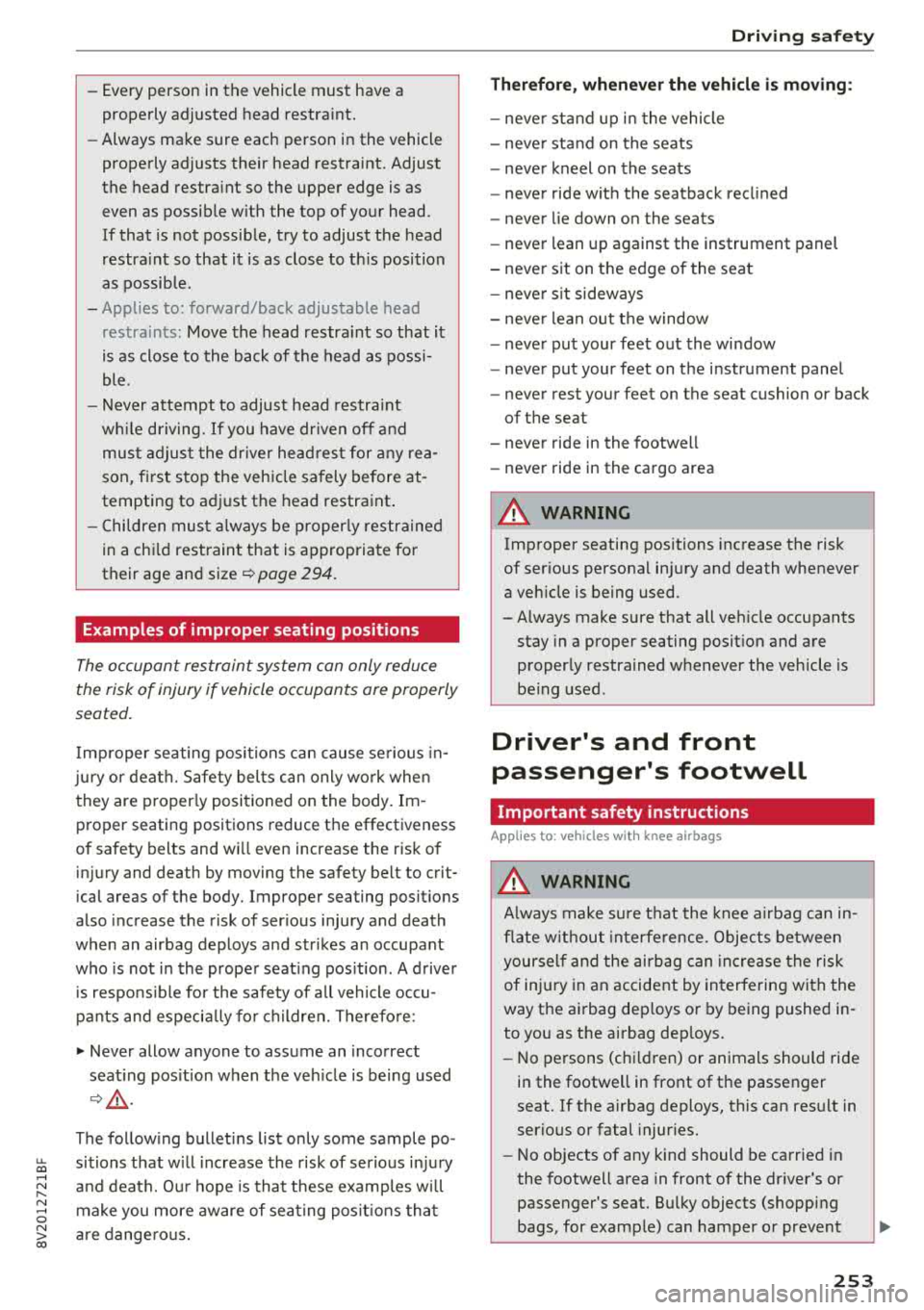
u. 00 .-< N l' N .-< 0 N > 00
-Every person in the vehicle must have a
properly adjusted hea d restra int.
- Always make sure each person in the vehicle
properly adjusts their head res traint. Adjus t
t h e head restra int so the upper edge is as
even as possib le with the top of your head.
If that is not possib le, try to adjust the h ead
restra int so that it is as close to th is position
as possib le.
- Applies to: forward/back adjustable head
restra ints: Move the head restra int so that it
is as close to the back of the head as possi
ble.
- Never attempt to adjust head restra int
wh ile driving. If you have dr iven off and
must adjust the dr iver head rest for any rea
son, first s top the veh icle sa fely before at
tempting to ad just the head restraint .
- C hildren mus t always be p roperly res trained
in a ch ild restraint that is appropriate for
their age and size
i::> page 294.
Examples of improper seating positions
The occupant restraint system con only reduce
the risk of injury if vehicle occupants ore properly
seated.
I mp roper seating posi tions can cause se rious in
ju ry o r death. Safety bel ts can only work when
they are p roperly positioned on the body. Im
proper seating positions reduce the effectiveness
of safety belts and w ill even increase the r is k of
in ju ry and death by moving the safety belt to crit
ical areas of t he body. Improper seating posit ions
also increase the risk of ser ious injury and death
when an airbag deploys a nd strikes an occupant
who is not i n the prope r seat ing pos ition . A d rive r
i s respons ib le for the safety of all vehicle occu
pants and especia lly fo r children. Therefo re:
"" Never allow anyone to assume an incorrect
seat ing pos it ion when t he ve hicle is being used
i::, & -
The follow ing bulletins list only some sample po
sitions that will increase the risk of serious in jury
a nd death. O ur hope is that these examp les w ill
make you more aw are of sea ting pos it io ns tha t
ar e dange ro us.
Dri ving saf ety
Th erefore , whenever the vehicle is moving :
-neve r st an d up i n the vehicle
- neve r stand on the seats
- neve r kneel on the seats
- never ride wit h the seatback recl ined
- neve r lie down on the seats
- never lean up against the instrument panel
- never sit on t he edge of the seat
- neve r sit sideways
- neve r lean out t he window
- neve r put your feet out the wi ndow
- never put your feet on the instrument panel
- neve r rest your feet on the seat cushion or back
of the seat
- never ride in the footwell
- never ride in the cargo area
A WARNING
--
Improper seating positions inc rease the risk
of ser ious personal in ju ry and death whenever
a veh icle is being used.
- Always make sure that all veh icle occupants
stay in a proper seating posit ion and are
proper ly restrained whenever the vehicle is
be ing used.
Driver's and front
passenger's footwell
Important safety instructions
Applies to : vehicles wit h knee airbags
A WARNING
Always ma ke su re t hat the knee airbag can i n
fl ate w ithout interfe rence. Objects between
yourself and the airbag can in cre ase the risk
of inju ry in an accident by interfering with the
way the ai rbag dep loys o r by being pushed in
to you as the ai rbag dep loys.
- No persons (ch ildren) or animals should ride
in the footwell in front of the passenger
seat . If the airbag deploys, this can res ult in
serio us or fatal injur ies.
- No objects of any kind should be carried in
the footwell area in front of the dr iver's or
passenger's seat. Bu lky objects (shopping
bags, for examp le) can hamper or prevent
~
253
Page 256 of 404
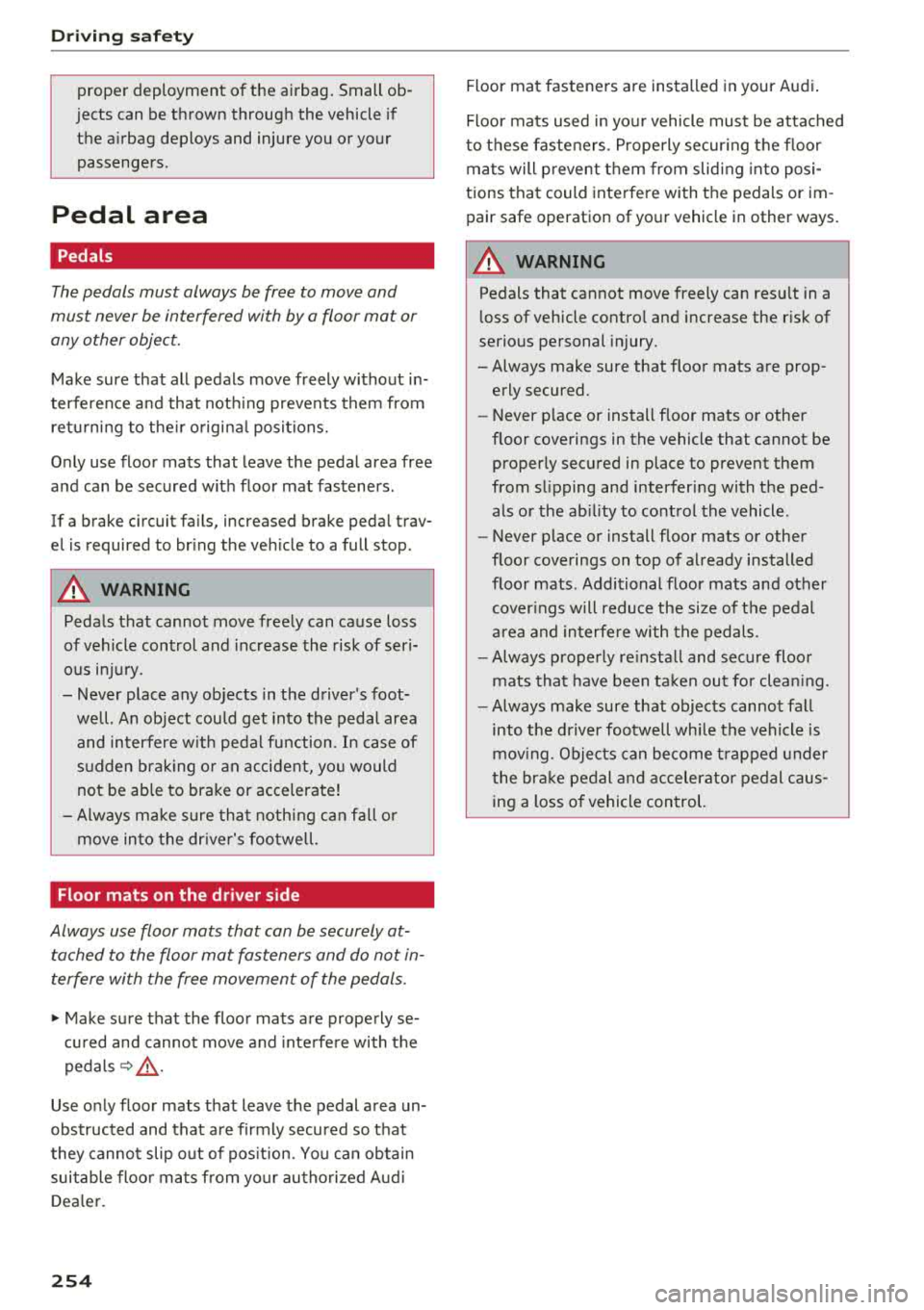
Drivin g saf ety
proper deployment of the airbag. Small ob
jects can be thrown through the vehicle if the a irbag deploys and injure you or your
passengers .
Pedal area
Pedals
The pedals must always be free to move and
must never be interfered with by a floor mat or
any other object.
Make sure that all pedals move freely without in
terference and that not hing prevents them from
retu rni ng to the ir origi na l positions.
Only use floor mats that leave the pedal area free
and can be secured with floor mat fasteners .
If a brake c ircuit fa ils, increased brake peda l trav
el is required to br ing the veh icle to a full stop .
A WARNING
Pedals that cannot move freely can cause loss
of vehicle control and inc rease the risk of ser i
ous
in Jur y.
-Never place any objects in t he driver's foot
we ll. An object cou ld get into the peda l area
and interfere w it h pedal fu nction. In case of
s u dden brak ing o r an accident, yo u wo uld
not be ab le to brake or accelerate!
- Always make sure that noth ing ca n fa ll o r
move in to the dr iver's foo twell .
Floor mats on the driver side
Always use floor mats that can be securely at
tached to the floor mat fasteners and do not in
terfere with the free movement of the pedals .
.,. Make sure that the floor mats are properly se
cu red and cannot move and inte rfe re with the
peda ls ~ & -
Use o nly floo r mats that leave the pedal a rea un
obstructed and that are firmly secured so that
they cannot slip out of pos it ion. Yo u ca n ob tain
sui table floo r ma ts from yo ur autho riz ed Aud i
Dea le r.
254
Floor mat fasteners are installed in your Audi .
Floor mats used in you r vehicle must be attached
to these fasteners . Properly secur ing the floor
mats will p revent them from slid ing into pos i
tions that could interfere with the pedals or im
pair safe operation of your vehicle in other ways.
A WARNING
Pedals that cannot move freely can res ult in a
l oss of vehicle contro l and increase the r isk of
serious personal injury.
- Always make sure that floor mats are prop erly secured.
- Never p lace or install floor mats o r other
floor coverings in the vehicle that cannot be properly secured in place to prevent them
from s lipping and interfer ing with the ped
als or the ab ility to control the vehicle .
- Never p lace or install floor mats or other
floor coverings on top of already installed
floor mats . Additional floor mats and other
cover ings will reduce the si ze of t he pedal
a rea and interfe re w ith the pedals.
- Always properly re insta ll and sec ure floo r
mats that have been ta ke n out for clea ning.
- Always make sure that objects cannot fall
into t he d river footwe ll whi le the vehicle is
mov ing. Objects can become t rapped under
t he br ake pedal and accelerator pedal c aus
ing a loss o f vehicle con trol.
Page 257 of 404
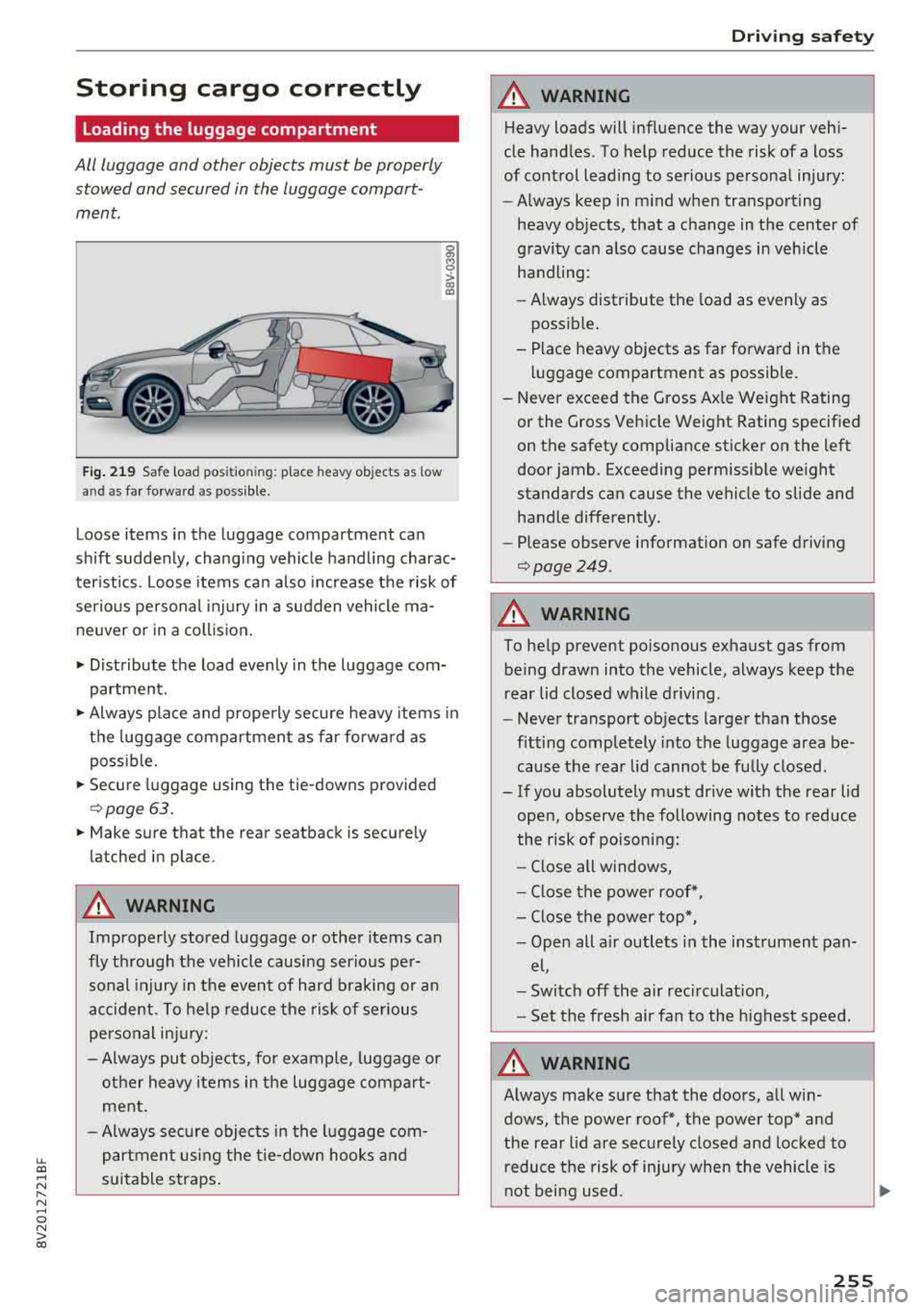
LL co .... N
" N .... 0 N > co
Storing cargo correctly
Loading the luggage compartment
All luggage and other objects must be properly
stowed and secured in the luggage compart
ment.
Fig . 219 Safe load pos itio ning : place heavy objects as low
an d as far forward as poss ible.
g M 0
> a, a,
Loose items in the luggage compartment can
shift suddenly, chang ing vehicle handling charac
ter istics . Loose items can also increase the risk of
serio us personal inj ury in a sudden vehicle ma
ne uver or in a coll ision.
• Distribute the load evenly in the luggage com
partment.
• Always place and properly secure heavy items in
the luggage compartment as far forward as
poss ible.
• Secure luggage using the tie-downs provided
¢ page 63.
• Make sure that the rear seatback is securely
latched in place .
A WARNING
Improperly stored luggage or other items can
fly through the vehicle causing serio us per
sonal injury in the event of hard braking or an
accident . To help reduce the risk of serious
personal injury:
- Always put objects, fo r example, luggage o r
other heavy items in the luggage compart ment.
- Always sec ure objects in the luggage com
partment using the tie-down hooks and
s u itable straps .
Driving safety
A WARNING
Heavy loads will influence the way your vehi
cle handles. To help reduce the risk of a loss
of control lead ing to serious personal injury:
- Always keep in m ind when transport ing
heavy objects, that a change in the center of
gravity can a lso cause changes in vehicle
handling :
- Always distribute the load as evenly as
possible .
- Place heavy objects as far forward in the luggage compartment as possible.
- Never exceed the Gross Ax le Weight Rating
or the G ross Vehicle Weight Rating specified
on the safety compliance sticker on the left
door jamb. Exceeding permissible we ight
standards can cause the vehicle to slide and handle differently.
- Please observe information on safe driving
¢page 249 .
A WARNING
-
To help prevent poisonous exhaust gas from
being drawn into the vehicle, always keep the
rear lid closed while driving.
- Never transport objects larger than those
fitting completely into the luggage area be
cause the rear lid cannot be fu lly closed.
- If you absolutely must dr ive with the rear lid
open, observe the following notes to reduce
the risk of poisoning:
- Close all windows,
- Close the power roof*,
- Close the power top*,
- Open alt a ir outlets i n the instrument pan-
el,
- Switch off the air rec irculat ion ,
- Set the fresh air fan to the highest speed.
A WARNING
--
Always make sure that the doors , all win
dows, the power roof*, the power top* and
the rear lid are securely closed and locked to
r educe the risk of injury when the vehicle is
n ot being used.
255
Page 258 of 404
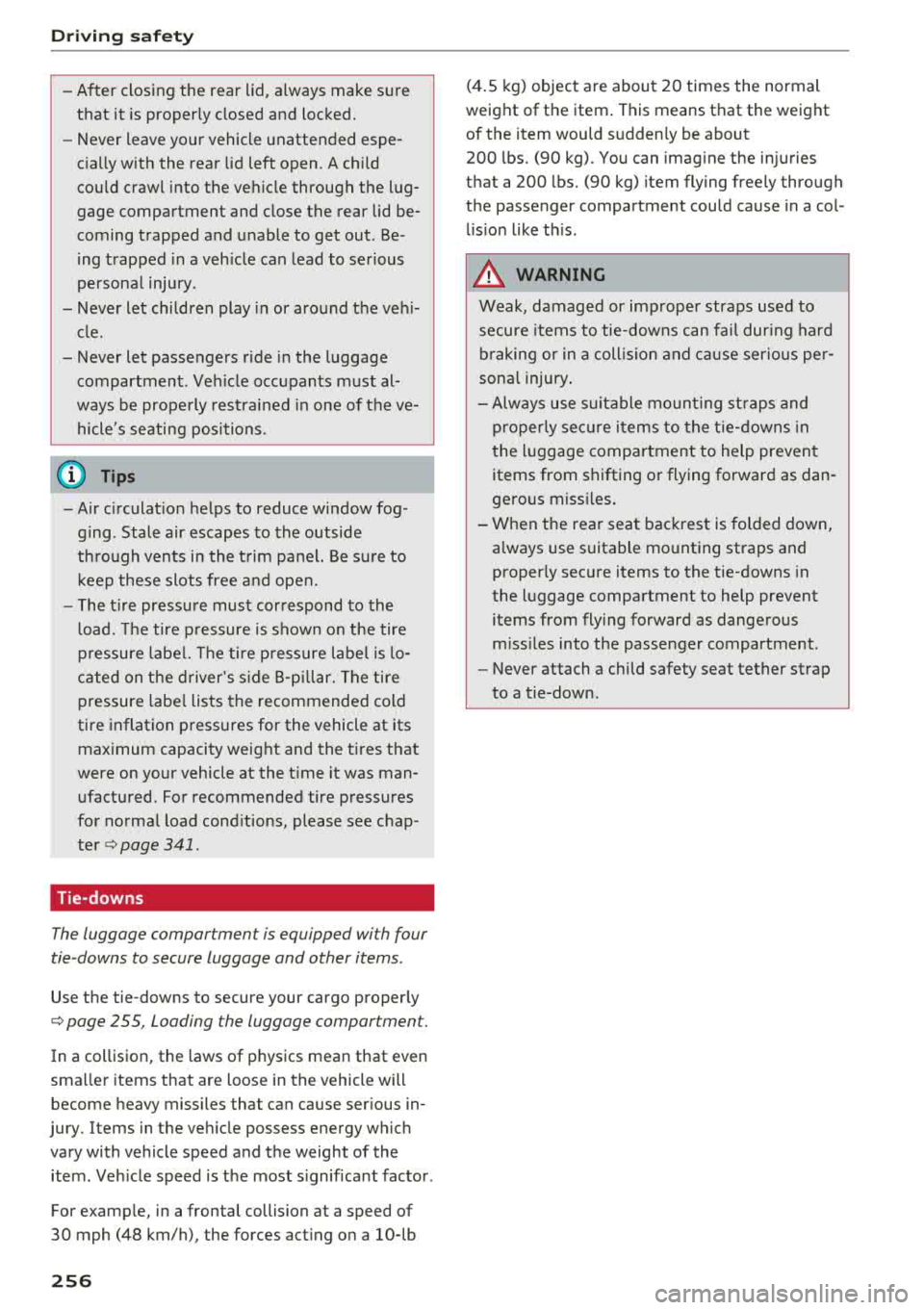
Drivin g saf ety
- After closing the rear lid, a lways make sure
that it is properly closed and locked.
- Never leave yo ur vehicle unattended espe
c ia lly w ith the rear lid left open. A ch ild
could crawl into the ve hicle through the lug
gage compartment and close the rear lid be
coming trapped and unable to get out . Be
ing t rapped in a veh icle can lead to se rious
persona l injury.
- Never let children play in or around the veh i
cle .
- Never let passengers ride in the luggage
compartment. Ve hicle occupants m ust al
ways be prope rly rest ra ined in one of the ve
hicle's seating posi tions.
(D Tips
- A ir c irculat io n helps to reduce window fog
g ing . Stale air escapes to the outside
th rough vents i n the t rim panel. Be s ure to
k eep these slots free and open.
- The t ire pressu re must correspond to the
l oad. The tire p ressure is shown on the tire
p ressure labe l. Th e tire pressu re labe l is lo
ca ted on t he driver 's s ide B-p illar. The tir e
p ressure labe l lists the recommended cold
tire inflation pressures for the vehicle at its max imum capacity weig ht and the t ires t hat
were on your vehicle at the t ime it was man
ufactured. For recommended tire pressures
for normal load cond itions, please see chap
ter
¢ page 341.
Tie-downs
The luggage compartment is equipped with four
tie -downs to secure luggage and other items .
Use the tie-downs to secure your cargo proper ly
¢ page 255, Loading the luggage compartment.
In a col lision, the laws of p hysics mean that even
sma ller items that are loose in the vehicle will
become heavy missiles that can cause ser ious in
jury. Items in t he ve hicle possess energy which
vary with vehicle speed and the weight of the item . Veh icle speed is the most s ignificant factor .
For examp le, in a frontal collision at a speed of
30 mph (48 km/h), the forces act ing o n a 10-lb
256
(4.5 kg) object are about 20 times the normal
weight of the item . This means that the weight
of the item would s udden ly be about
200 lbs. (90 kg). You can imag ine the in juries
that a 200 lbs. (90 kg) item flying freely through
the passenger compartment could cause in a col
l is ion like t his.
A WARNING
Weak, damaged or imp roper straps used to
secure items to tie-downs can fa il dur ing hard
b raking or in a coll is ion and cause ser io us pe r
sona l injury .
- Always use s uitable mo unt ing st raps and
p roper ly sec ure i tems to the t ie -downs in
the l uggage compa rtment to help preven t
items from shifting or flying forward as dan
ge rous missi les .
- W hen the rear seat backrest is fo lded down,
a lways use s uitable mo unting straps and
properly sec ure items to the tie-downs in
the luggage compartment to help prevent items from flying forward as dangerous
m iss iles into the passenger compartment.
- Never attach a child safety seat tether strap
to a t ie-down.
-
Page 259 of 404
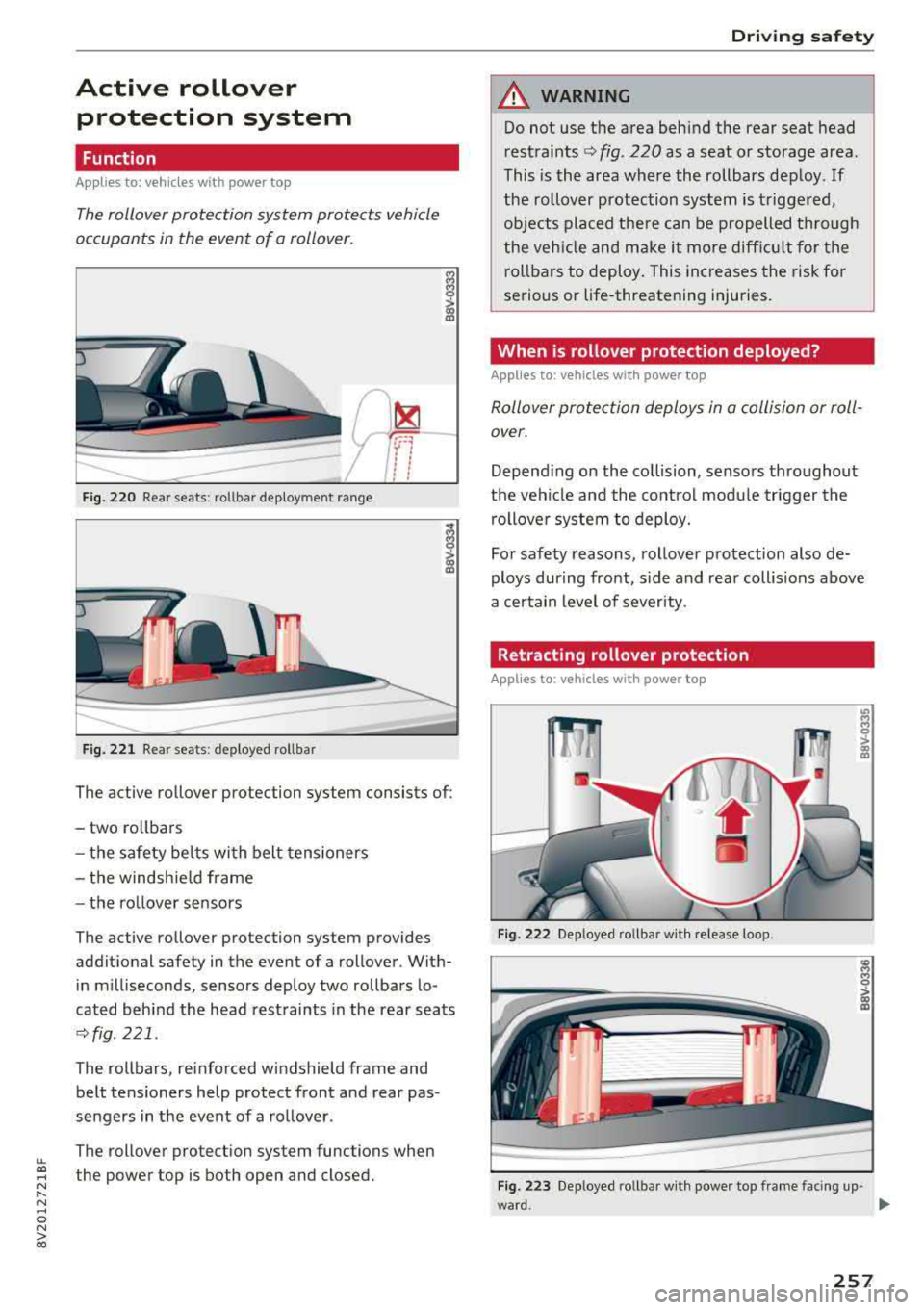
LL co .... N
" N .... 0 N > co
Active rollover protection system
Function
Applies to: vehicles wit h power top
The rollover protection system protects vehicle
occupants in the event of a rollov er.
........ ..._____ ----
F ig. 220 Re ar seats: rol lb ar deploy men t ran ge
----
Fig. 221 Rear seats: deployed rollbar
,.-., I ~--, 1' I
' ' I ' I I
The ac tive rollover prote ction sys tem consists of :
- two ro llbars
- the safety belts with belt tensioners
- the windshie ld frame
- the rollover sensors
The active rollover prote ction system provides
additional sa fety in the event of a rollover . With
in m illiseconds, sensors deploy two rollbars lo
cated behind the head restraints in the rear seats
¢ fig. 221 .
The rollbars, re inforced windshield frame and
belt tensioners help protect front and rear pas
sengers in the event of a rollover .
The rollover protec tion system functions when
t he power top is both open and closed .
Dri ving safety
A WARNING
Do not use the area behind the rear seat head
restraints
¢ fig . 220 as a seat or storage area .
This is the area where the rollbars deploy . If
the rollover protection system is t riggered,
objects placed there can be p ropelled th rough
the veh icle and ma ke it more diffic ult for the
r ollbars to deploy. This increases the risk for
serious or life -threatening injuries.
When is rollover protection deployed?
Applies to: veh icles w ith power top
Rollover protection deploys in a collision or roll
over.
Depend ing on the co llision, senso rs thro ughout
the vehicle and the co ntro l modu le trigger the
rollove r system to deploy.
For safety reasons, rollover protection also de
ploys during front, s ide and rear collisions above
a certain level of severity.
Retracting rollover protection
Applies to: veh icles w ith power top
Fig . 222 De ployed ro llbar wi th release loo p.
-
~
8
> CD a,
Fig. 223 De ployed ro llbar w ith powe r to p frame facing up·
-~-~
257
Page 260 of 404
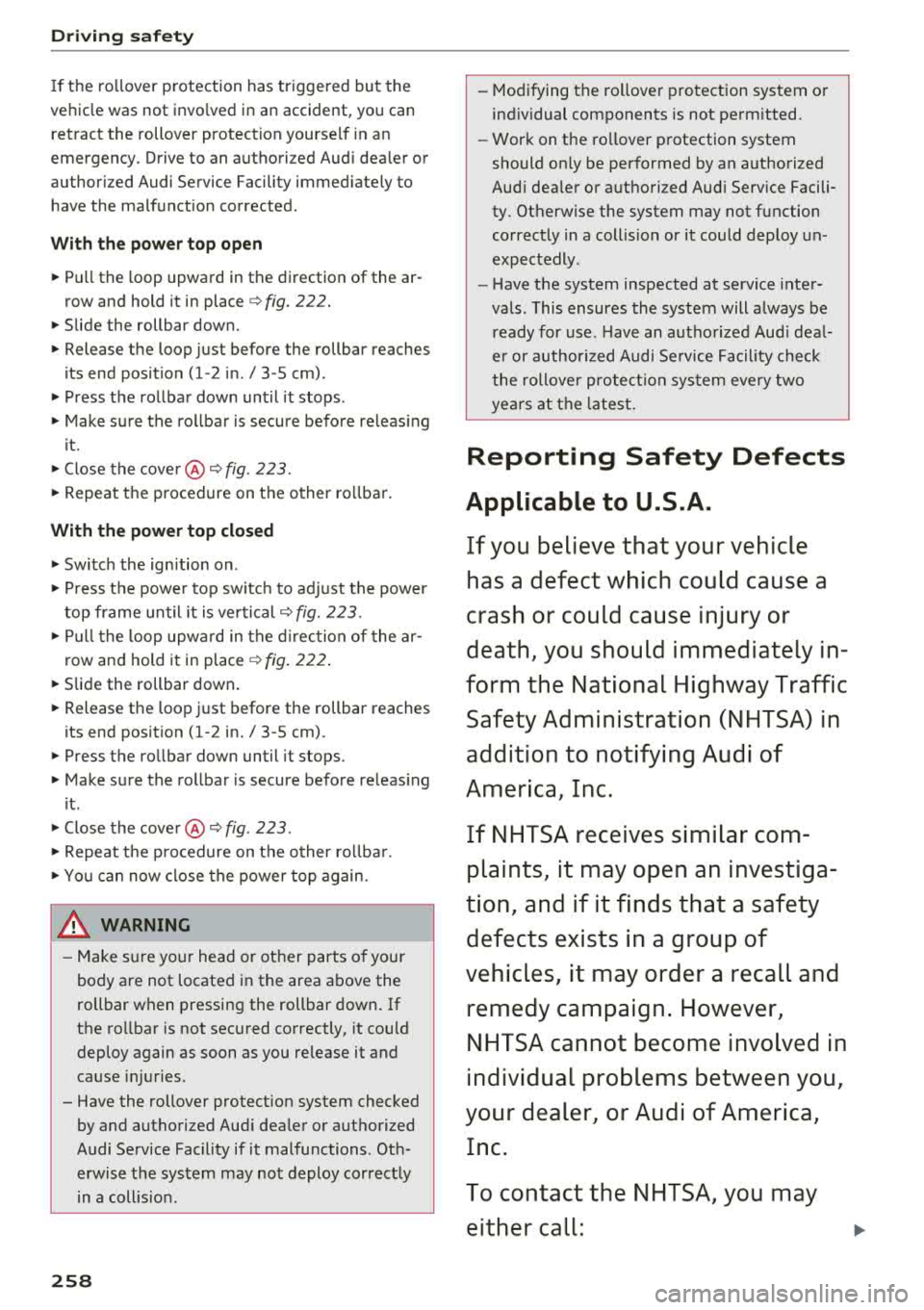
Drivin g saf ety
If the ro llover protection has triggered but the
vehicle was not invo lved in an accident, you can
retract the rollover protection yourself in an
emergency. Drive to an authori zed Aud i dea ler or
author ized Audi Service Facility immed iate ly to
have the malfunction corrected .
With the power top open
~ Pu ll the loop upward in the direction of the ar
row and hold it in place
¢ fig . 222.
~ Slide the rollbar down.
~ Release the loop just before the rollbar reaches
its end position ( 1-2 in ./ 3 -S cm) .
~ Press the rollbar down until it stops .
~ Make su re the rollba r is secure befo re re leas ing
i t.
~ Close the cove r@ ¢ fig. 223.
~ Repeat t he p rocedure on t he other ro llba r.
With the power top closed
~ Switch the ign ition on .
~ Press t he power top switc h to ad just the power
top frame until it is
ve rtical ¢ fig. 223.
~ Pull t he loop upwa rd in the d irection of the ar
row and hold it in place
¢ fig. 222 .
~ Slide the rollbar down.
~ Release the loop just before the rollbar r eaches
its end position (1 -2 in./ 3-5 cm).
~ Press the ro llbar down until it stops.
~ Make sure the rollbar is secure before releas ing
i t .
~ Close the cover @¢ fig. 223 .
~ Repeat t he p rocedure on t he other ro llba r.
~ Yo u can now close the power top again.
A WARNING
- Make s ure your head or other parts o f your
body are not located in the area above the
rollbar when pressing the rollbar down. If
the ro llbar is not secured correctly, it cou ld
deploy again as soon as you re lease it and
cause i njuries.
- Have the rollover protect ion system checked
by and authorized Aud i dea ler or authorized
Audi Service Facility if it malfunctions . Oth
erwise the system may not deploy correctly
in a coll is io n.
25 8
-Modifying the rollover protection system o r
ind ividual components is not perm itted.
- Work on the ro llover protection system
should on ly be performed by an authorized
Aud i dea ler or authorized Audi Serv ice Facili
ty. Otherwise the system may not function
correct ly in a collis ion or it could dep loy un
expectedly.
- Have the system inspected at service inter
vals . This ensures the system will a lways be
ready fo r use . H ave an autho rized Aud i dea l
er or author ized Audi Se rvice Facility check
the rollove r protect ion system eve ry two
ye ars at the latest.
Reporting Safety Defects
Applicable to U.S.A.
If yo u beli eve th at your vehicle
ha s a def ect w hi ch could cau se a
c ras h or co uld cause inju ry or
d ea th, you sh ould imm edi ate ly in
form the N atio nal Highway Traffi c
Sa fet y Admini stration (NHT SA) in
a dditi on t o notif yin g Au di of
A m er ica, Inc.
If NHTSA rece ives s imilar com
plaints, it ma y ope n an in ve stiga
tion , and if it find s that a safet y
defect s exis ts in a group of
v ehicle s, it ma y order a recall and
rem edy campaign. H owev er,
NHT SA cann ot become in vol ved in
indi vidual probl em s bet ween you,
y our dealer, or Audi of America,
In c.
T o co nt ac t the NHTSA , you ma y
either call :